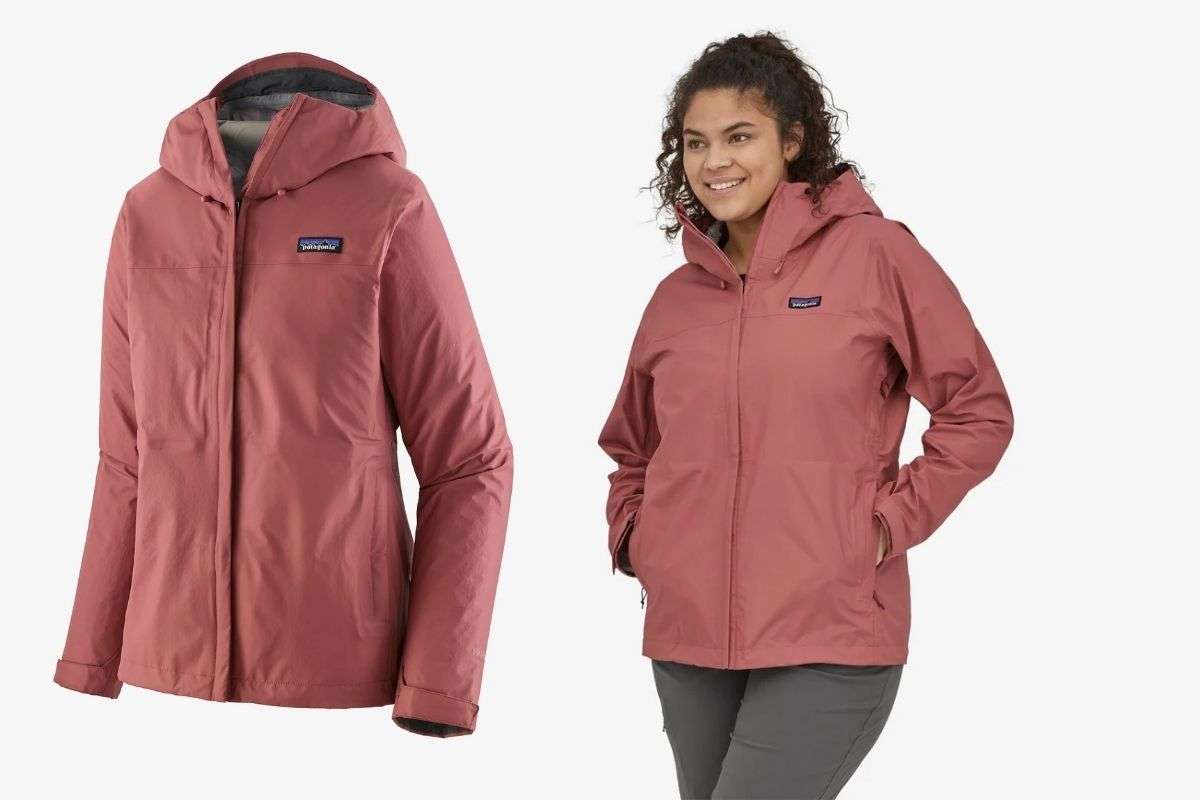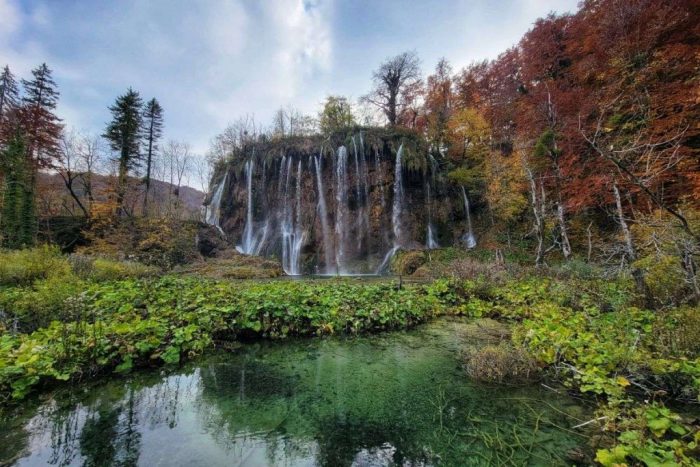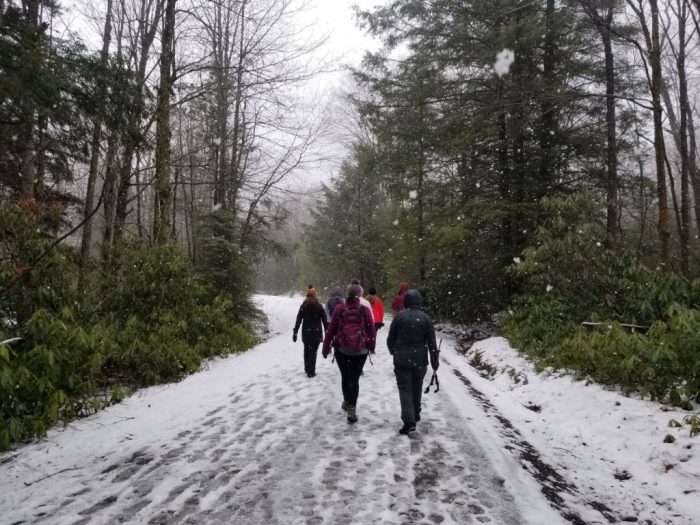Hiking in the Rain? Here’s the Gear We Use (and Recommend)

*Disclosure: we independently choose all product recommendations. When you buy from product links in our posts, we may earn a small commission at no extra cost to you. This supports our ability to provide the best advice possible.
This is a part of our review series, where we give detailed reviews of all of the gear that we use on our trips. You can see the full list of gear here.
If you think that rainy days call for staying indoors curled up with a cup of tea and a good book, then you’re missing out on rainy outdoor adventures. Sure, hiking in dry weather in the summertime with a sprinkling of warm rain sounds idyllic…
…but there’s something magical about being Out There when Mother Nature does her thing.
Wet socks, and bad weather while on your multi day backpacking trip? Not so much.
Fear not! With a little preparation, a good rain jacket, and waterproof hiking shoes, you’ll be a pro at rainy day hikes and know how to stay warm and stay dry in no time.
Today, we’ll go over how to prep for a rainy season of hiking, our preferred backpacking gear for tackling rainy weather, as well as some quick tips when you find yourself caught in bad weather and need to ride it out for a few hours before the rain stops.
With any luck, a little rain won’t put a damper on your outdoor adventure – you might even enjoy hiking in the rain!
What to Do Before Hiking in Rain
Hiking in the rain is as much about how you prepare beforehand as it is the actual hike! Here are a few suggestions to equip yourself ahead of time while keeping safe, for your next rainy hike.
- Check the weather: Despite seemingly good weather when first checking the forecast, weather can shift and temperatures can drop at any point throughout your hike. Being properly prepared starts with monitoring the weather forecast ahead of time, including preparation for extreme weather conditions, such as lightning safety.
- Check your trail: Slippery trails when hiking in the rain have the potential to turn dangerous. Selecting a hike that is consistently monitored, such as trails within a national park, help to plan ahead for rugged trail conditions.
- Check your gear: Assess what gear to bring and inspect your gear condition. Your former self will thank you for packing waterproof shoes when hiking in the rain. Setting up camp overnight in rainy conditions? Packing a sleeping bag, and wool socks, as well as dry bags to store dampened clothing, will keep you dry against poor weather.
Essential Hiking Rain Gear
Escape cold weather by trying on one of the following pieces of equipment for size. We also offer you tips and tricks for what to look for when purchasing gear, as well as brand suggestions.
Rain Jacket
A good top layer jacket can make or break how good an experience it will be with your hiking gear. When faced with heavy rain, the entire hike can feel like an uphill battle (no pun intended).
Hiking rain jackets are water resistant and keep layers dry underneath during sustained rainfall. A windproof rain jacket eliminates wind chill as well and is your safest bet when hiking in higher altitudes.
Our go-to is the Patagonia Women’s Torrentshell 3L Rain Jacket. A winning combination of breathability and waterproof comfort, it’s no wonder Explorer Chick Guide Kirstie Mullikin raves about this durable jacket to wear hiking.

Kirstie
April 26th, 2021The only Patagonia I own. Keeps me dry in the red storms and lightweight. I like the brim that keeps rain out of your eyes!
If you want something a little more heavy weight (ie made of Gortex), then the Outdoor Research Women’s Aspire GORE-TEX® Jacket 2021 is a great option, recommended by Explorer Chick Jeannie Panchal.

Jeannie
April 26th, 2021I’m a huge fan of anything with goretex, After going through 3 rain jackets in the last 10 years, I realized I need something more durable. I wear the Outdoor Research Aspire jacket in Alaska and it’s fantastic. If anything goes wrong OR return/repair policy is amazing!
Not only is the jacket super waterproof, but it also is well ventilated (this kind of material can get hot and sweaty fast without proper ventilation). It’s also got a bunch of gadgets, like clips and zip covers, to help make your overall experience more convenient and easy. And when you’re hiking in the rain, that’s everything.
Rain Pants
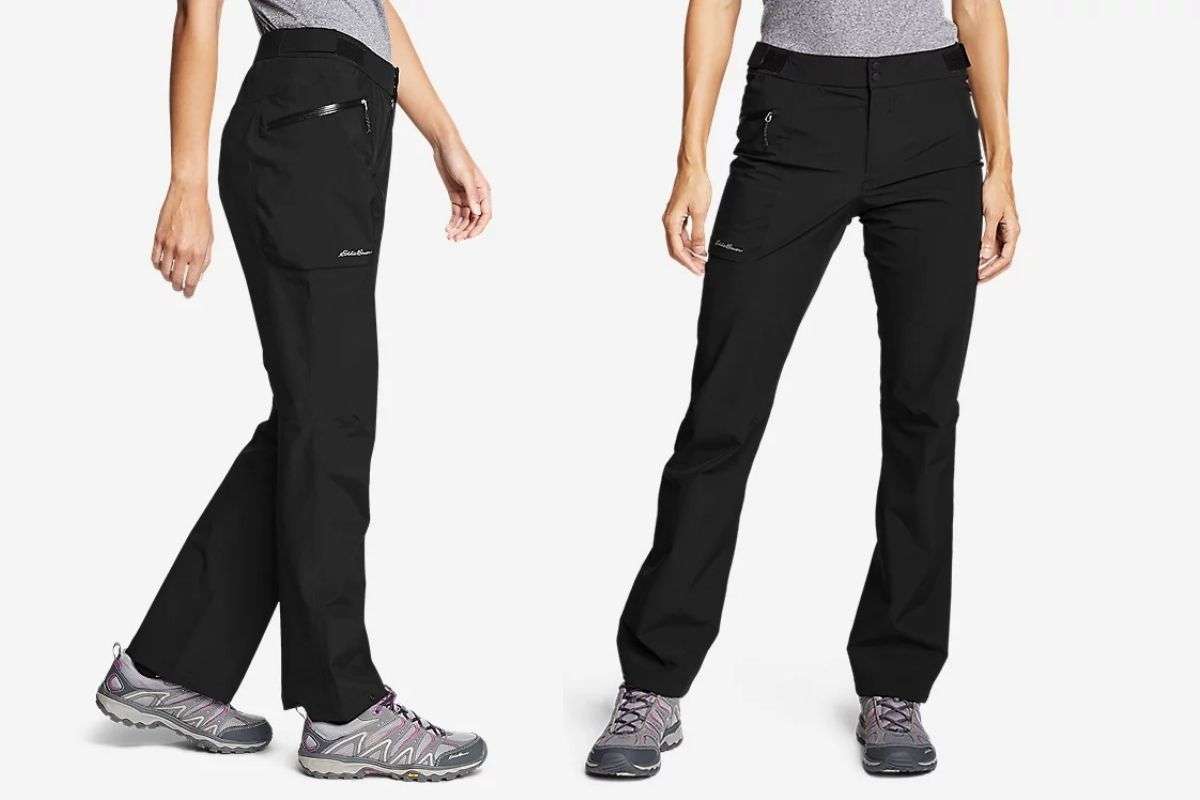
Waterproof pants are another important component when it comes to quality gear. Choosing purposely-made hiking pants with waterproof qualities keep you dry (and optimistic) on a rainy hiking trail.
You’d be surprised how much rain falls at exactly a perpendicular angle to your marching thighs. (hint: A LOT)
Eddie Bauer’s Cloud Cap Rain Pants are a stretchy yet comfortable option for your next pair of waterproof hiking pants. They also have a quality elastic waistband to keep from falling down!
People who have bought these pants and worn them say that there is enough space to fit a base layer underneath. People also can’t get over how cute and flattering they are 💃
Waterproof Boots
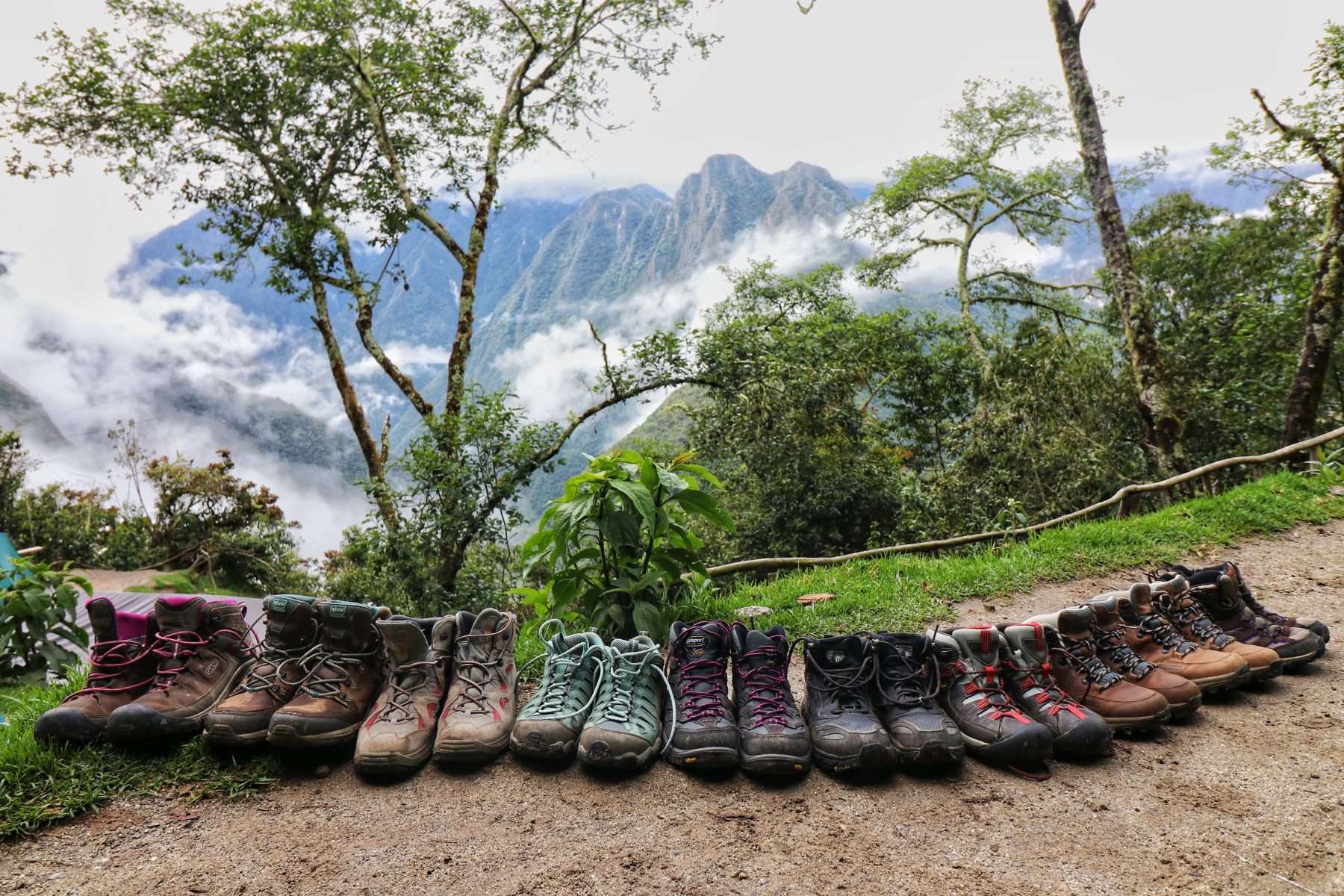
Hiking boots are no match for slippery rocks while keeping your socks dry. Protect your toesies with a high quality pair of waterproof footwear.
Fit and comfort, traction, ankle support, and waterproofing, are all great factors to consider when purchasing the right pair of boots for your outdoor needs. These bad boys are so important for happy hiking that we wrote an entire guide on how to choose the right hiking boots.
Additional protection, like a gaiters wrap, also helps on trails with deeper puddles and also keeps your legs and feet warm. But more on that below…
Insulating Layers

Layering clothing keeps you warm, dry, and insulated against all weather conditions, whether it be a light drizzle or torrential downpour. The key is to layer your clothes in a way that uses your body heat to your advantage. There are basically three layers:
- Your base layer wicks moisture (AKA sweat) away from your skin, preventing the moisture from cooling your body temperature.
- Your insulating layer is where you build and trap heat around your body, most often done with fleece.
- Your outer layer protects you from the elements, like wind, rain, snow, etc. Gore-Tex makes a great outer layer for its durability.
Ideal layering options include
- wool,
- synthetic wicking material,
- silk,
- and fleece.
These materials are breathable, quick-drying material that helps to deter hypothermia in colder climates.
Another pro-tip? Avoid cotton: Cute for your summertime outfit, your worst nightmare for cold rain. Cotton retains water, meaning wet gear, and a potential loss of body heat.
We wrote an in-depth guide on how to layer clothing during winter, for more examples of how to layer your clothing properly.
Pack Raincover
A rain cover protects your gear from getting soaked through (and prevents your pack from getting heavy with soaked materials). Choosing a design like the light and compact Gregory Pro Rain Cover will keep your pack dry without adding extra weight to your load.
Recommended Hiking Gear for Wet Weather
You’ve got the clothing and boots down pat—what about extra gear? We’ve got some added equipment suggestions to help your wet weather hiking go according to plan!
Hiking Poles
A solid pair of trekking poles help to maintain your balance when tackling uphill trails and protect your knees when hiking downhill. One of our Explorer Chick guides swears by Leki poles. “Titanium, ultralight, and foam grips are things I look for. I also prefer the 2-speed lock adaptors as opposed to simple lock mechanism (the kind that breaks into three sections and looks like nunchucks).”
Ziplock Bags
Well-versed in carrying snacks, or serving as a clean-up item when packing up your campsite after a fun overnight trip, plastic bags and Ziploc bags are also great options for storing wet clothing separately from other items. Consider bringing multiple sizes of bags to suit your needs, from drenched t-shirts and pants to wet socks and undies. The gallon size freezer bags will do the trick 👌
Read our entire list of things to bring with you on a hike for more tips like this.
Gaiters
Sometimes you need a little extra reinforcement for your waterproof rain boots or hiking shoes to keep the wetness out. That’s where gaiters come in. A nifty piece of equipment, gaiters are designed to provide protection against the elements and keep the tops of your footwear from getting wet.
Different types of gaiters are available for different types of activities, including hiking, and trail running, and come in varying heights depending on the level of required protection. For your next gaiters purchase, try the Kahtolla LEVAgainter Tall GTX Gaiters. Available in three sizes and made of Gore-Tex, these gaiters are best suited for backpacking, making them lightweight and easy to pack for overnight hiking trips.
Gloves
Keep your hands and fingers warm with a high-quality pair of water-resistant gloves. We’ve touched on the importance of gear equipped with water protection and breathability. For gloves, this is no different, even going so far as to look for gloves with seam taping. Used to lock out water from reaching your hands and fingers in super rainy or wet conditions, seam taping is a crucial factor to look for when deciding on your next purchase of hiking gloves… without it, your hands could get damp and cold anyway!
Our pick is the Pertex Shield Revel Shell Mitts. Designed using seam tape and offering a solid grip for handling hiking poles or grabbing onto ledges, these gloves are a small investment for quality lightweight, moisture-wicking gloves.
Quick Tips for a Rainy Day Hike
- Look out for hypothermia: Dampened clothing from sweat or rain leads to an increased risk of catching hypothermia. Purchase layers that come with rain shell protection, and are equipped with a waterproof, or breathable membrane.
- Bring a warm drink: A warm beverage for a cold, rainy hike, can heat the hands and warm the soul. Tea or hot water with lemon is always a great option.
- Bring lots of snacks: Packing high-protein snacks like beef jerky, and energy bars, are a great source for quick energy on the go. Eating big snacks infrequently is easier on your stomach when hiking or on the go, too.
Quick Tips for Rainy Backpacking
Preparing to backpack or camp overnight in the rain? Try a few of these quick tips!
- Bring a rain tarp: Versatile and easily packable, rain tarps keep your temporary home dry for the night. Shield the front of your tent, use for overall coverage of your base camp, or use as a foundation for your tent, keeping you and the floor dry.
- Pack a separate set of dry clothes for sleeping: Hiking in wet clothes is one thing. Sleeping in wet clothes? Yuck! A separate set of dry sleeping clothes means reducing the chances of catching hypothermia, while getting a good night sleep warm and protected from the elements.
Get on the Trail with Explorer Chick!
No matter the weather conditions, Explorer Chicks are always prepared! Book today for your next hiking trip with Explorer Chick! We promise to bring the warm drinks 😏
Meet the Writer
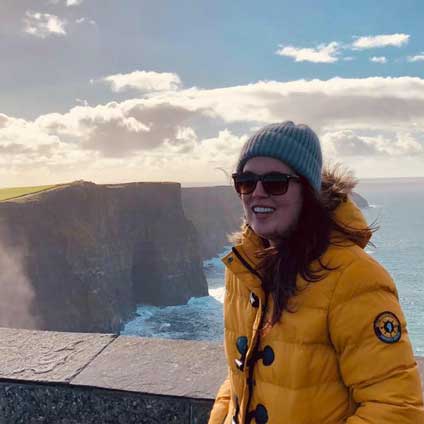
Lindsay Stroud
Lindsay Stroud is a freelance content writer and ghostwriter from Vancouver, Canada. Her published works can be found on Jiyubox and Passion Passport, in addition to producing ghostwritten content for Owl Labs and Wonderment. Her favorite destinations include Berlin, Stockholm, and Florence. In her spare time, you’ll find her exploring local foodie joints throughout her neighborhood, or planning itineraries for future trips.
Favorite Outdoor Adventure: spending time by the ocean and exploring walking trails in her local neighborhood.
See more of our recommended gear
- Best Inflatable Rafts, Kayaks, And Paddleboards That We Swear By
- Going for a Hike? Here’s the Best Hiking Clothes for Women
- How to Use Trekking Poles 101
- Hiking in the Rain? Here’s the Gear We Use (and Recommend)
- Review: Kula Cloth, The Antimicrobial Pee Cloth For Hiking
- Review: Garmin inReach Mini
- Review: MSR Ceramic 2-Pot Set
- What Can You Not Take On A Plane? The Outdoor Woman’s Guide.
- Review: the Ultralight MSR Pocket Rocket 2 Canister Stove
- Review: Jetboil MiniMo Cooking System

